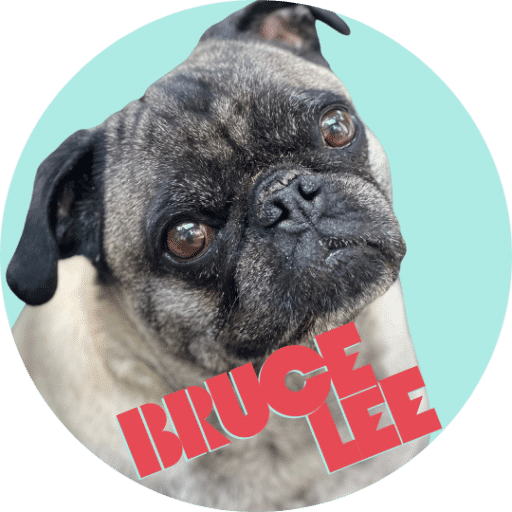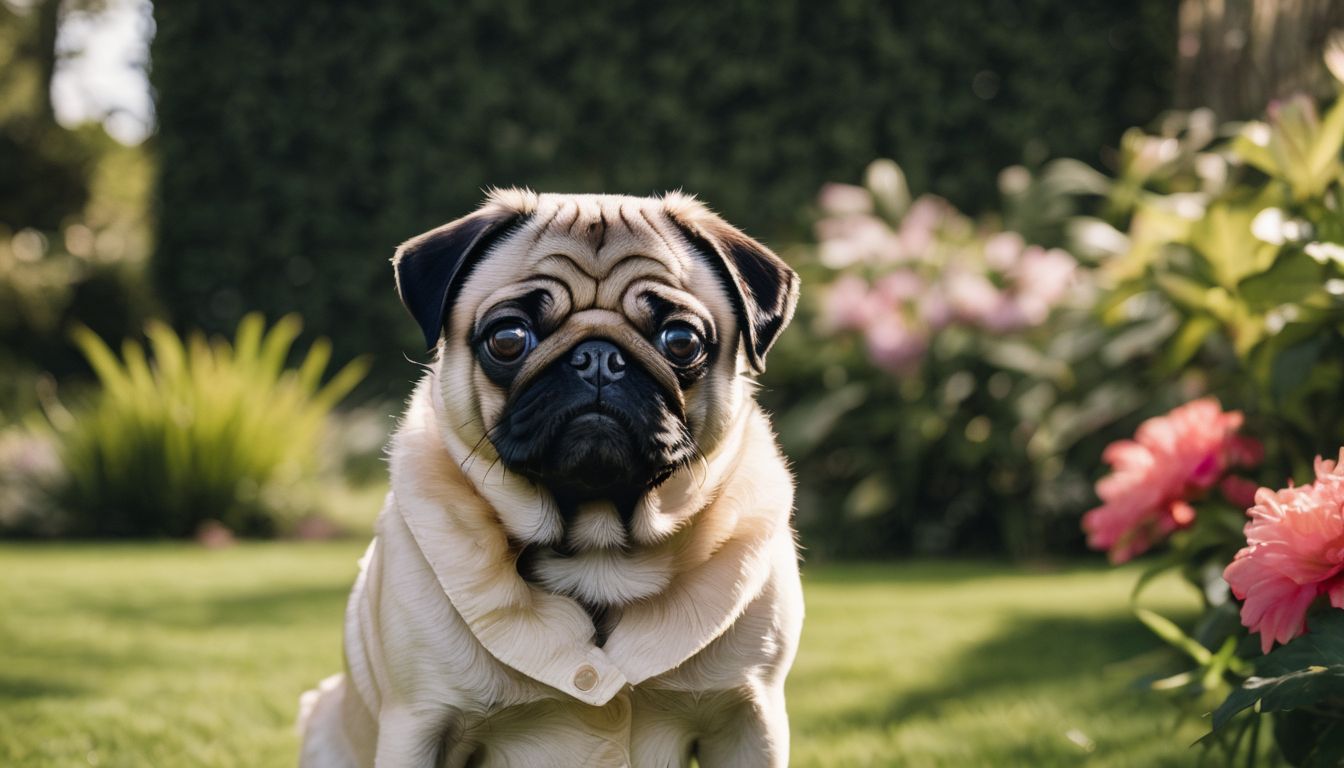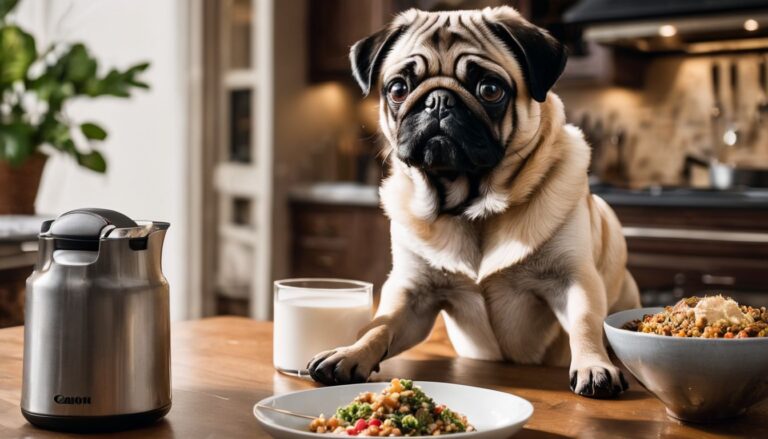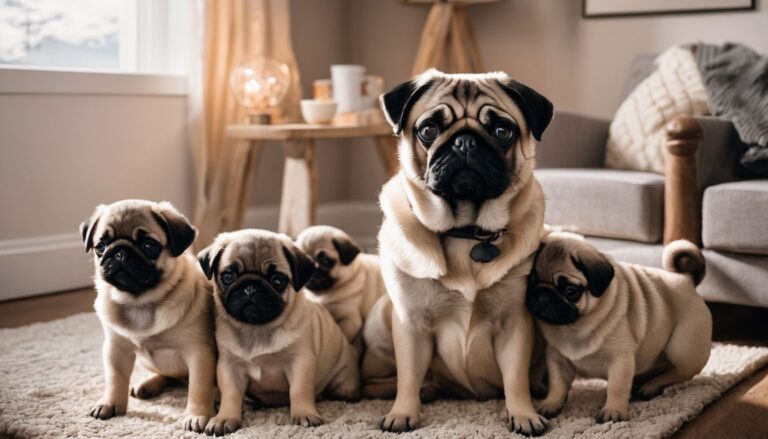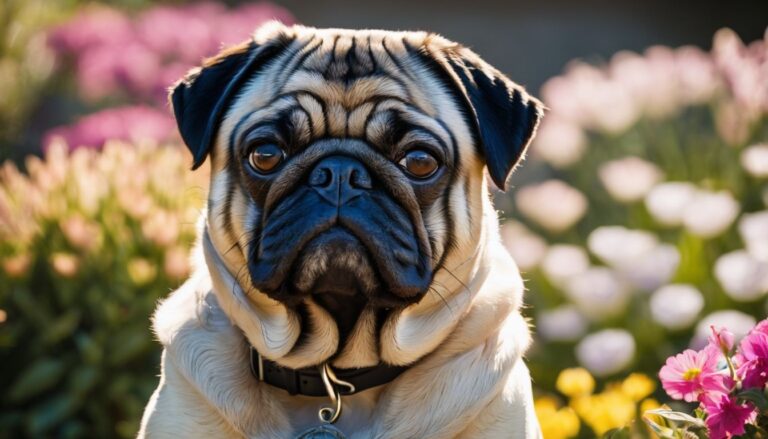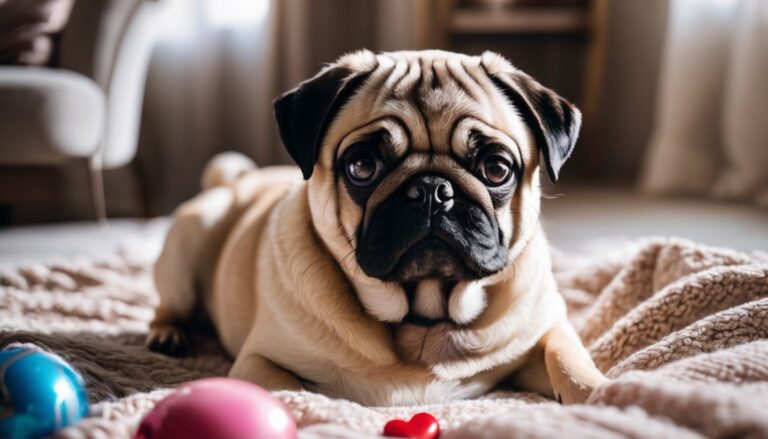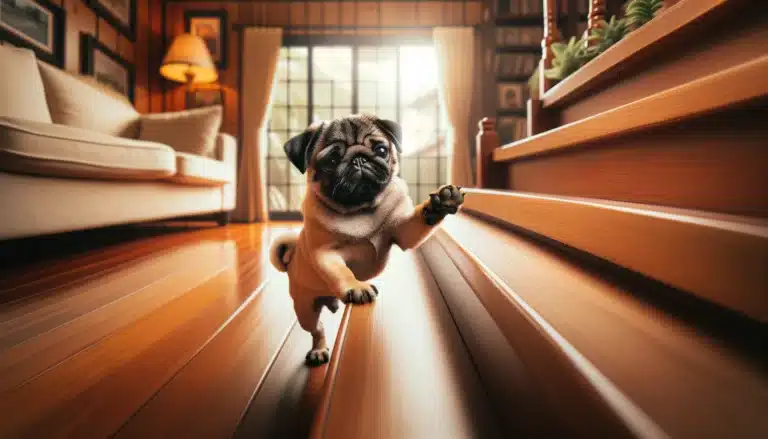Are Pugs Ugly? Unveiling The Controversy: Short Answer – No!
Are Pugs Ugly?
The age-old debate rages on: are pugs cute or just plain ugly? For many of us, this furry question has led to some serious head-scratching. With a treasure trove of research at our fingertips and a soft spot for these snub-nosed pals, we’re on a mission to unwrap the enigma of their peculiar appeal.
In this post, we’re going full Sherlock Holmes on the case of the pug’s unique charm—tracing their noble roots and shining a light on those irresistibly charismatic quirks. Buckle up; you’re about to experience pugs from an entirely fresh perspective!
Key Takeaways
- Pugs’ distinct appearance from brachycephaly has led to a divided opinion on their cuteness, with some finding their smushy faces and rolled tails adorable while others may consider them unattractive.
- Despite physical traits that can lead to health issues, such as breathing difficulties and skin infections, pugs are cherished for their affectionate nature, loyalty, and ability to bond closely with owners.
- The history of pugs dates back to ancient China where they were selectively bred for companionship by the nobility—a trait which is reflected in their sociable behavior today.
- Proper care for a pug includes regular cleaning of skin folds and ears as well as monitoring for respiratory problems. Additionally, early training using positive reinforcement is crucial for this breed.
- Ultimately, whether one finds pugs cute or ugly is subjective; what remains consistent is their enduring popularity due to their loving personalities and historical significance.
The Controversy: Are Pugs Ugly?
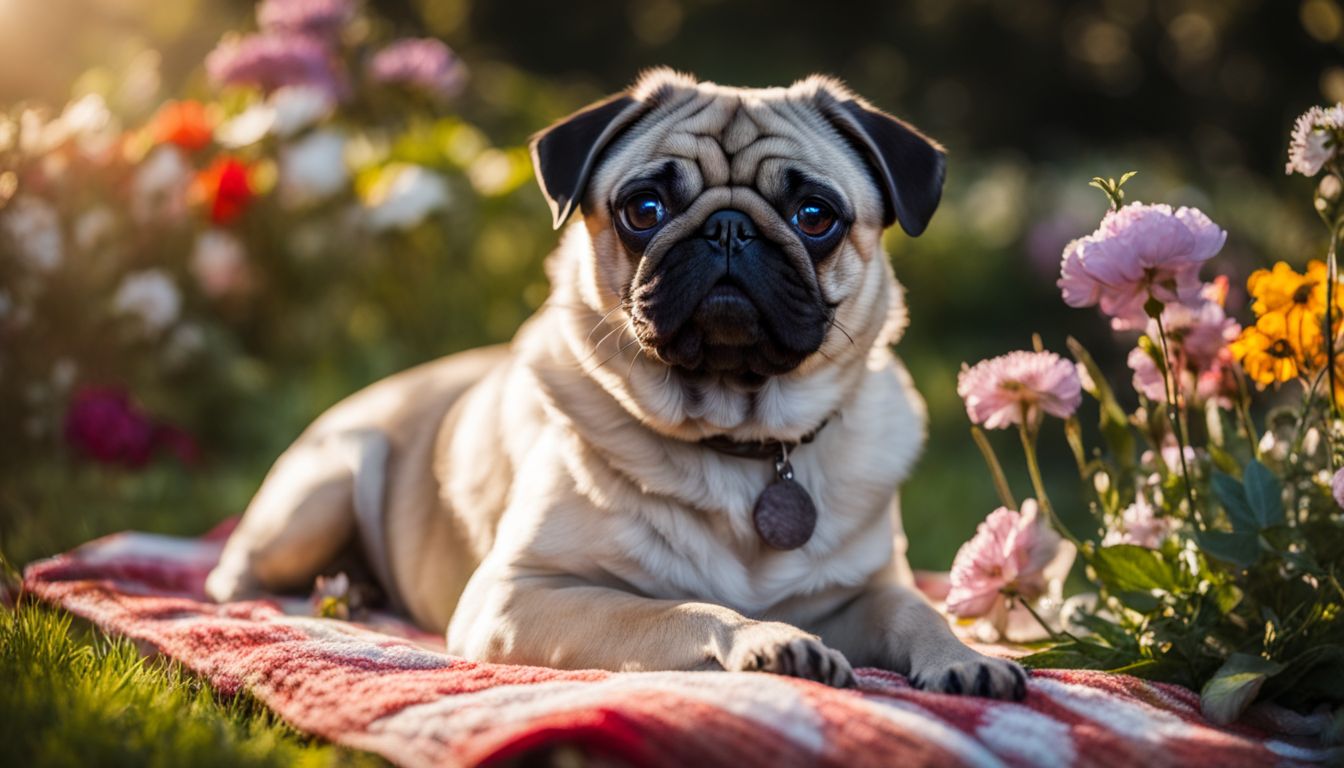
Pugs often stir up a lively debate about their looks. Some people insist these small dogs with distinctive wrinkled faces and big, expressive eyes are the epitome of canine cuteness.
Their smushy faces and robust little bodies draw a legion of fans who find them irresistibly adorable. But not everyone sees pugs through the same affectionate lens; critics point to their bulging eyes and underbites as markers of ugliness.
We must acknowledge that beauty is in the eye of the beholder when it comes to dog breeds. Pugs carry traits like rolled tails and velvet ears that some may not favor, while others might see these features as endearing quirks unique to the breed.
They snort, they snore, but most importantly, they bring boundless joy and companionship to many households worldwide.
Reasons Why Pugs Are Considered Ugly

Pugs are often considered ugly due to their smushy face and bulging eyes, underbite and pig-like tail, skin rolls and small ears, wrinkles and rounded shape, as well as the snoring and snorting sounds they make.
However, these features are a result of centuries of selective breeding rather than inherent unattractiveness.
Smushy face and bulging eyes
Our pug’s distinctive smushy face and big, round eyes certainly stand out in the dog world. These features might look a bit unusual to some, but they’re part of what makes our little friends so special.
Their compact noses and expressive eyes are traits that many of us have come to adore. We know these characteristics often lead people to believe they’re looking at an “ugly” breed.
However, we see a charm in their unique appearance that goes beyond traditional beauty standards. Those bulging eyes seem to gaze into our hearts with pure love and loyalty. Sure, the smushy face might cause some health issues due to brachycephaly—a condition where breathing can be more difficult for the dog—but as responsible owners, we know how important it is to keep an eye on their health.
It’s all about understanding and embracing every aspect of our pugs’ looks.
Underbite and pig-like tail
Pugs often sport a distinctive underbite that gives them a quirky charm. Their teeth set apart in uneven gaps, which is easily noticeable when they pant or await treats with excitement.
This unique feature of their bite isn’t found in many breeds, but it’s one of the trademarks of our beloved pugs.
Their tails are just as special, curled up in a way that reminds us of miniature piglets. The tight curls result from spinal deformities but don’t usually affect the happiness and wagging enthusiasm our little friends show every day.
Each curl is like a fingerprint, making each pug’s tail uniquely theirs – an endearing twist that adds to their unmistakable silhouette.
Skin rolls and small ears
Pugs have skin rolls that need regular cleaning and care to prevent health issues like yeast infections, chafing, and skin fold dermatitis. These folds can trap moisture and bacteria, making it crucial to keep them dry and clean.
Pugs also have small ears which require regular inspection for signs of infection or irritation. Due to their shape, small ears are prone to ear problems, so it is essential to keep the ears clean and dry consistently.
Maintaining a pug’s skin rolls hygiene through regular cleaning is vital for preventing potential health issues such as yeast infections, chafing, and skin fold dermatitis due to trapped moisture and bacteria.
Wrinkles and rounded shape
Pugs have a distinctive appearance with their wrinkled and rounded face, a result of their brachycephalic breed. This characteristic trait is directly linked to the breed’s shortened muzzle and pushed-in nose, contributing to the adorable yet unique look that distinguishes pugs from other dog breeds.
The rounded shape of pugs not only adds to their charm but also prompts increased vigilance for potential breathing problems due to airway constriction associated with this feature.
Their wrinkled face, which is considered an endearing quality by many pug enthusiasts, serves as a defining physical attribute that epitomizes the breed’s character. Furthermore, it contributes to the overall appeal and recognition of pugs in the canine world.
Snoring and snorting
Pugs look like they’ve been hit with a brick, which leads to snoring and snorting due to their flat, button noses and droopy lips. Their big, round, bulging eyes give off an uncomfortable stare and are often accompanied by more snorting and snoring.
Additionally, their noticeable underbite contributes to the uneven gaps between their teeth and further exacerbates the snoring and snorting issues. The curly shape of Pugs’ tails also poses challenges as it is similar to that of pigs due to spinal deformities that can result in even more frequent bouts of snoring and snorting.
The Science Behind Pug’s Looks
Pugs’ unique appearance is due to a condition called brachycephaly, which results in their smushed face and bulging eyes. This breeding practice has caused health risks for Pugs, leading to a debate on whether their distinctive look is worth the potential health issues.
Brachycephaly and its health risks
Pugs’ distinctive appearance is due to brachycephaly, a condition resulting in shorter noses and breathing difficulties. This causes various health risks such as respiratory problems, visual issues, and higher susceptibility to infections.
Additionally, the unmistakable facial features of Pugs with their small button nose, droopy lips, and bulging eyes are directly linked to the impact of brachycephaly on their overall well-being.
The noticeable underbite along with wide gaps between teeth in Pugs can lead to oral health concerns while their skin rolls may result in conditions like yeast infections and chafing.
Historical breeding practices
Pugs were selectively bred in China to have a distinctive squished face and curly tail, traits that appealed to the nobility, reflecting status and affluence. This selective breeding led to the iconic adorable appearance of Pugs, with their smushed noses and wrinkled foreheads.
The emphasis on aesthetic features during historical breeding practices resulted in health issues such as breathing difficulties due to brachycephaly being overlooked.
In ancient China, Pugs were revered for their unique appearance and charming personalities, raised exclusively by emperors and aristocrats. Their breed characteristics were meticulously crafted through generations of selective mating, resulting in the distinctive flat-faced look that is now synonymous with Pugs worldwide.
The Pug’s History
Originating in Ancient China, Pugs have a rich history of association with royalty and nobility. Their unique appearance and charming personality have made them beloved companions throughout the centuries.
Origin in Ancient China
Pugs have a fascinating heritage that traces back to ancient China, dating as far back as 400 B.C. They were originally bred to be cherished companions for the Chinese aristocracy and royalty, serving as loyal and affectionate lap dogs.
With their endearing personalities and delightful nature, Pugs quickly captivated the hearts of people in China before making their way onto the global stage during the 16th century.
Not only were Pugs valued for their adorable appearance, but they also held significant cultural importance in ancient China due to their association with nobility. This rich history highlights the deeply-rooted bond between Pugs and human companionship that has endured for centuries, reflecting the enduring appeal of these beloved canine companions.
Association with royalty
Pugs have a regal history, with their origins tracing back to ancient China where they were bred as companions for the elite and royalty. Their distinctive features, such as the wrinkled forehead known as the “Prince’s Mark,” were highly valued in royal circles.
In fact, this association with nobility and wealth contributed to the development of specific physical traits that are now characteristic of pugs, making them unique and beloved by many.
The history of pugs dates back to 400 B.C. in China and gained international recognition during the 16th century when they made their way to Europe. The distinct connection between pugs and royalty has contributed to their endearing charm and continues to captivate dog lovers across the globe.
The history of Pugs
Pugs have a captivating history that dates back to ancient China, where they were bred as companions for the ruling families. They were esteemed as symbols of royalty and privilege, and their distinctive appearance quickly captured the hearts of those in power.
Following their introduction to Europe in the 16th century, Pugs gained widespread popularity among European royalty, solidifying their status as cherished pets within elite circles.
Notably, historical figures such as Queen Victoria and Napoleon Bonaparte were known for adoring these endearing creatures, further elevating the breed’s prestige.
The enduring legacy of Pugs is evidenced by their frequent depiction in art, literature, and royal portraits throughout history. This reinforces their iconic status and enduring appeal across different cultures.
The Debate: Are Pugs Ugly or Cute?
While some may argue that Pugs are ugly due to their unique physical features, others find them undeniably cute and charming. To delve deeper into this debate, let’s explore the various perspectives and factors that contribute to this ongoing controversy.
Dive into the fascinating world of Pugs to uncover the truth behind their adorably distinctive appearance.
Arguments for Pugs being ugly
Pugs are often considered ugly due to their distinct features, such as their smushy face, bulging eyes, and skin rolls. Additionally, their underbite and pig-like tail shape contribute to the perception of ugliness. Pugs’ small ears and wrinkled appearance also add to this viewpoint.
Moreover, brachycephaly, which causes their unique facial structure, is a major factor in why some perceive Pugs as unattractive. Furthermore, the health risks associated with these features can lead to discomfort and medical issues for the breed. The design of Pugs’ breeding that accentuates these characteristics has led to widespread concerns about their appearance among dog enthusiasts.
- Pugs have a delightful and playful disposition, often displaying an amusing sense of humor that brings joy to those around them.
- Their expressive eyes and wrinkled faces exude a unique charm, captivating many with their adorable appearance.
- Pugs are known for their loyalty and devotion, forming strong emotional connections with their human family members.
- Their gentle and loving nature makes them exceptional companions, offering comfort and support to their owners during both joyful and challenging moments.
- Despite their small stature, Pugs possess a confident and lively personality that adds a vibrant energy to any household.
- The endearing snorting and snoring sounds they make only add to the overall lovable character of these delightful dogs.
- Pugs’ affectionate nature extends beyond their immediate family, as they often become fast friends with other pets in the household.
Are Pugs affectionate?
Pugs exhibit an affectionate and loving nature, often forming strong bonds with their human companions. Their loyalty and devotion make them ideal family pets, as they thrive on human interaction and attention.
Additionally, Pugs are known for their playful and friendly demeanor towards other pets and children, showcasing their amiable and warm-hearted disposition.
These qualities make Pugs highly sought after as devoted and affectionate companions to owners of all ages. They enjoy being part of the family dynamic, gladly engaging in cuddles, playtime, and quality moments with those they hold dear.
Pug’s Behavior and Traits
Pugs are known for their affectionate and sociable nature, often forming strong bonds with their owners. They are relatively quiet dogs that rarely bark excessively, and they tend to be calm and gentle pets.
Pugs also display a protective instinct towards their families, making them loyal companions.
Do Pugs bark a lot?
Pugs are not known for excessive barking; instead, they are relatively quiet dogs. While occasional barking may occur, it is not a defining characteristic of the breed. Pugs generally do not exhibit persistent or noisy barking behavior, making them well-suited for living in various environments without causing disturbances.
Their tendency to bark infrequently aligns with their amiable and adaptable nature, often making them an excellent choice for individuals seeking a calm and composed companion. This attribute distinguishes Pugs as an ideal pet option for those who prefer a quieter living space and minimal disruptions from excessive canine vocalization.
Are Pugs smart?
Pugs are known for their intelligence and adaptability, often excelling in obedience training. They have a willingness to please and can learn commands quickly, making them quite responsive to training efforts.
Their affectionate nature allows them to form strong bonds with their owners, demonstrating an intuitive understanding of emotions and moods. Pug owners often find that these dogs exhibit problem-solving abilities and demonstrate independent thinking when faced with various situations.
With proper socialization, mental stimulation, and consistent training methods, Pugs can show remarkable cognitive skills leading to well-behaved companionship. These qualities make Pugs not only endearing but also intelligent pets that bring joy and lasting connections into the lives of their owners.
Are Pugs hyper?
Pugs can be energetic and lively, especially when they’re young. They enjoy playtime and love being the center of attention. Engaging in regular exercise helps them release pent-up energy, contributing to a more balanced temperament.
It’s essential to provide them with mental stimulation through interactive toys and games to keep their hyperactivity in check.
Owners should also establish daily routines for feeding, exercise, and rest to help manage Pug’s energy levels effectively without becoming too hyperactive. Maintaining consistent training methods can aid in keeping their excitement at manageable levels while fostering good behavior.
Are Pugs calm?
Pugs exhibit a calm and laid-back demeanor, making them well-suited for apartment living or owners who prefer a less active lifestyle. Their gentle and affectionate nature also means they get along well with children and other pets, bringing warmth and comfort to the home.
While Pugs may display occasional stubbornness, they are generally easygoing and adaptable to different living situations, always seeking attention from their owners and charming everyone with their loving disposition.
Knowing that Pugs can sense their owner’s moods further highlights their comforting presence in times of need.
Are Pugs protective?
Pugs are generally not known to display protective behaviors, as they tend to be friendly and sociable with people and other animals. While Pugs may bark to alert their owners of strangers, they are not considered a highly protective breed due to their small size and amicable nature.
Their affable disposition makes them better suited as companions rather than guard dogs.
Their small size and friendly nature make them more likely to be sociable than protective; however, it’s important for owners to provide proper training and socialization for Pugs in various environments.
Are Pugs aggressive?
Pugs are not generally known for being aggressive dogs. They are often described as playful, affectionate, and good with children and other pets. Pugs’ friendly and sociable nature makes them a great choice for first-time dog owners due to their gentle temperament.
Additionally, these easygoing and adaptable dogs typically aren’t aggressive guard dogs but may bark to alert their owners of unfamiliar people or noises.
Pug Care and Considerations
Pug training tips and advice on how to potty train a Pug are essential for new owners. Understanding what to feed a Pug puppy and addressing common concerns such as smelly or farting issues can contribute to a happy and healthy relationship with your pet.
Pug training tips
We recommend starting pug training early and being consistent with positive reinforcement. Here are essential pug training tips for Pug Lovers of the World:
- Start basic obedience training as soon as possible.
- Use treats or rewards to reinforce desired behaviors.
- Socialize your pug from an early age to ensure they are well – adjusted and friendly.
- Keep training sessions short and engaging to maintain their attention.
- Use a firm but gentle approach when correcting undesirable behavior.
- Teach your pug to walk on a leash without pulling.
- Establish a routine for potty training, rewarding successful trips outside.
- Encourage mental stimulation through interactive toys and games to prevent boredom and destructive behavior.
- Seek professional help from dog trainers if you encounter persistent issues with training.
How to potty train a Pug
To potty train a Pug, it’s important to understand their breed-specific needs and potential health risks associated with their small size. Here are some tips to effectively potty train your Pug:
- Place the potty training area in a consistent location indoors to establish routine and familiarity for your Pug.
- Use positive reinforcement like treats and praise when your Pug successfully uses the designated potty spot to encourage good behavior.
- Establish a regular feeding schedule for your Pug to regulate their bathroom habits and make potty training more predictable.
- Take your Pug outside frequently, especially after meals, naps, or playtime, to reinforce outdoor potty habits.
- Clean up accidents immediately with an enzymatic cleaner to remove odor and discourage repeat indoor accidents.
- Be patient and consistent with the potty training process, understanding that breed – specific health issues may affect your Pug’s progress.
- Consider employing crate training as a supplemental method to assist in potty training your Pug by leveraging their den instincts.
What to feed a Pug puppy
When feeding a Pug puppy, it’s essential to provide high-quality dog food specifically formulated for small breed puppies. Opt for a well-balanced diet that includes lean protein, healthy fats, and complex carbohydrates to support their overall growth and development.
Look for puppy food with the right amount of nutrients like calcium for bone health and DHA for brain development. To prevent obesity and dental issues, portion control is crucial, so stick to the recommended feeding guidelines based on your Pug puppy’s age and weight.
Additionally, incorporate occasional healthy treats into their diet to keep them motivated during training sessions, but be mindful of not overdoing it as excess treats can lead to weight gain.
Are Pugs smelly?
Pugs can have a distinctive odor due to their skin folds, which can trap moisture and become a breeding ground for bacteria. Regular cleaning of the facial wrinkles and skin folds is essential for preventing any unpleasant smells.
Additionally, Pugs are prone to flatulence, contributing to potential odors. Proper grooming, including regular baths and dental care, can help manage any scent issues associated with Pugs.
Pug Care Tip: Keeping your Pug’s skin folds clean and dry can reduce the likelihood of smelly odors developing. Regular bathing and dental hygiene will also help maintain a fresh-smelling Pug.
Can Pugs live outside?
Pugs can live outside, but they are indoor dogs and thrive best in a temperate climate. Due to their shortened noses, Pugs are sensitive to extreme temperatures, making them prone to breathing difficulties in hot weather.
It’s important to provide ample shade, water, and supervision if they spend time outdoors. Also, be cautious of leaving them outside for prolonged periods as they may overheat or suffer from frostbite in colder conditions.
Pug owners should monitor their pets closely and ensure that the outdoor environment is safe from potential hazards like toxic plants or other animals that could harm the dog. Additionally, regular exercise and social interaction are crucial for Pugs’ well-being, so providing opportunities for physical activity while spending time outdoors is essential for maintaining their health and happiness.
Pug Health and Well-being
Pug health and well-being are crucial for their overall happiness, so it’s important to understand their lifespan, cost, weight management, shedding tendencies, and more. To learn about how to care for your Pug’s health needs, read on in the next section.
Lifespan of Pug
The lifespan of a Pug generally ranges from 12 to 15 years. Due to their brachycephalic nature, Pugs can be prone to certain health issues that may impact their overall lifespan. Like all breeds, the longevity of a Pug depends on various factors including genetics, diet, exercise, and proper healthcare.
It is important for Pug owners to be attentive to their dog’s well-being in order to ensure a long and healthy life for their beloved pet.
Pug health concerns contribute significantly to their average lifespan. Owners should closely monitor their dental hygiene and weight management as these are key factors in maintaining the overall well-being of a Pug.
How much does a Pug cost?
Pugs generally cost between $600 to $1,500. The price varies based on factors such as the breeder’s reputation, the Pug’s pedigree, and its location. It is essential to consider additional expenses like veterinary care, food, grooming, and other essentials when budgeting for a Pug.
Are all Pugs fat?
Many Pugs are prone to becoming overweight due to their love for food and lack of exercise. Keeping a close eye on their diet, providing regular physical activity, and avoiding overfeeding can help prevent obesity.
Extra weight puts strain on a Pug’s joints and can exacerbate breathing difficulties associated with their brachycephalic anatomy. Maintaining a healthy weight is essential for enhancing the overall well-being and longevity of these lovable companions.
Regular vet check-ups, portion control, and choosing high-quality, balanced dog food can contribute significantly to preventing obesity in Pugs. Vigilance in monitoring their body condition and adjusting food intake according to activity levels are crucial factors in keeping them fit and healthy.
Do black Pugs shed?
Black Pugs, like their fawn counterparts, are known to shed moderately. Their short double coat requires regular care to minimize shedding. Regular brushing and bathing can help control the shedding of black Pugs, keeping their coat healthy and minimizing loose hair around the house.
Good grooming practices are essential for managing shedding in black Pugs.
The key to minimizing shedding in black Pugs is consistent care – regular brushing and occasional baths can significantly reduce loose hair around your home. Keep up with a grooming routine to manage shedding effectively and keep your black Pug’s coat in top condition.
Pugs in Comparison with Other Breeds
When comparing Pugs to other breeds, it’s important to consider their unique characteristics and temperament. While some may argue that Pugs resemble certain dogs like the Puggle or the French Bulldog, each breed has its own distinct traits that make them special in their own right.
Dogs that look like Pugs
While dogs that look like pugs aren’t exactly the same, they share some endearing similarities. Here are several breeds that bear a resemblance to our beloved pugs:
- Chinese Cresteds – These slender, elegant dogs with their hairless bodies and tufts of fur on the head and feet may remind you of a pug due to their compact size and expressive eyes.
- Affenpinschers – With their broad, round heads and large, dark eyes, these small, wiry-haired dogs could easily be mistaken for a distant cousin of the pug.
- Brussels Griffons – Known for their distinctive facial features including a pushed-in nose and an expressive gaze, Brussels Griffons possess an undeniable charm similar to that of pugs.
- Pekingese – The Pekingese boasts a long history as an ancient breed with a smushy face, long hair, and big personality—traits that draw parallels to those of our beloved pugs.
- West Highland Terriers – These small but sturdy dogs have a lively expression due to their bright eyes and folded over ears, making them reminiscent of the adorable face of a pug.
- Yorkie Poos – A combination of Yorkshire Terriers and Toy Poodles results in fluffy little companions with soulful eyes that can easily capture hearts like those of pugs do.
- French Bulldogs – Bearing a strikingly similar appearance due to their smushed faces and bat-like ears, French Bulldogs share many physical characteristics with the charming pug.
- Schnauzers – The alert expression combined with bushy eyebrows gives these spirited terriers an uncanny resemblance to our darling pugs.
- Pomeranians – Small but exuberant with fluffy coats and bright eyes, these lively creatures have an attractive charm much like our endearing pugs.
Puggle vs Pug
As Pug lovers, we often find ourselves curious about the similarities and differences between Pugs and their crossbreed cousins, Puggles. Below is a comparison to help us appreciate the unique qualities of each breed.
| Feature | Pug | Puggle |
|---|---|---|
| Nose Length | Short (Brachycephalic) | Longer, reducing breathing issues |
| Facial Structure | Bulging eyes and pronounced underbite | More proportionate face, fewer droopy lips |
| Eyes | Bulging characteristic | Not bulging, appears more “normal” |
| Underbite | Pronounced | Less prominent |
| Tail | Curly due to spinal deformities | Less curly, resembles Beagle’s tail |
| Skin Rolls | Multiple and deep | Fewer rolls, less skin problems |
| Ears | Small | Longer, posing fewer ear problems |
We always strive to understand our beloved dogs better, and a side-by-side comparison like this brings clarity to the distinctions that make Puggles and Pugs stand apart. Both breeds have their own unique charm, but it’s clear that Puggles offer some health advantages due to their physical features. Despite these differences, Pugs hold a special place in our hearts with their distinctive looks and endearing personalities.
Pug vs French Bulldog
When it comes to comparing Pugs to French Bulldogs, both breeds have their unique charm and share certain similarities, but also possess distinct differences that endear them to us as Pug lovers.
| Characteristic | Pug | French Bulldog |
|---|---|---|
| Brachycephaly | Yes, with associated health risks. | No, but they do have a brachycephalic skull structure with related health concerns. |
| Underbite and Teeth Gaps | Noticeable underbite with uneven gaps between teeth. | Also has an underbite with uneven and wide gaps between teeth. |
| Tail | Curly shape due to spinal deformities. | Straight tail. |
| Health Concerns | Prone to dental problems and obesity. | Health issues may arise from their brachycephalic nature. |
| Breeding Origins | Bred for companionship to royalty in ancient China. | Originally companion dogs for lace workers in England. |
Both breeds bring joy and companionship to our lives, each with their own historical significance and health considerations. Whether you cherish the curly-tailed Pug or the straight-tailed French Bulldog, these canine friends have earned their places in the hearts of dog enthusiasts around the world.
Pug vs English Bulldog
As pug lovers, we often hear debates comparing our favorite squishy-faced companions to other breeds, like the English Bulldog. Both breeds have their unique charm and set of characteristics, which can attract different types of dog lovers. Here’s a quick comparison to help us appreciate the differences and similarities between Pugs and English Bulldogs.
| Feature | Pug | English Bulldog |
|---|---|---|
| Origins | Bred as companion dogs for Chinese royalty. | Originally used for bull-baiting in England. |
| Appearance | Small, muscular with a wrinkly, short-muzzled face, and curled tail. | Medium-sized, hefty dog with a wrinkled face and distinctive pushed-in nose. |
| Brachycephalic Traits | Yes, they have a flat face and small nose, leading to breathing issues. | Yes, similar breathing challenges due to a shortened snout. |
| Temperament | Generally affectionate, even-tempered and sociable. | Known for their courageousness and friendly, calm demeanor. |
| Health Concerns | Prone to obesity, dental problems, and skin fold dermatitis. | Susceptible to similar issues, with added concerns like hip dysplasia. |
| Lifespan | Typically 12-15 years with proper care. | Often 8-10 years, due to their size and health issues. |
| Activity Level | Relatively low; needs regular but moderate exercise. | Low to moderate; requires regular exercise to prevent obesity. |
| Shedding | Sheds moderately but more seasonally. | Sheds regularly; may require more frequent grooming due to fur texture. |
| Size | Small, typically 14-18 pounds. | Larger, usually ranging from 40-50 pounds. |
Both Pugs and English Bulldogs have a lovable nature that can win the hearts of many. They require attentive care, especially concerning their health needs and potential for obesity. Whether we’re drawn to the Pug’s perky persona or the Bulldog’s noble nature, these breeds share a legacy of close companionship with humans that makes them more than just pets—they’re part of our families.
Are Pugs Ugly Conclusion
In conclusion, the perception of pugs being ugly is a subjective matter. Despite their unique physical features, many people find pugs endearing and cute. The debate over pugs’ appearance may continue, but ultimately, their loving nature and charming personality overshadow any perceived “ugliness.” Ultimately, the decision on whether pugs are attractive or unattractive lies in the eye of the beholder.
Are Pugs Ugly FAQs
1. Why do some people think pugs are ugly?
Some people may find pugs ugly due to their unique features like a flat face and wrinkles, which can be different from more traditional dog breeds.
2. Are there other dogs considered uglier than pugs?
While beauty is subjective, the Pekinese or Brussels Griffon might also be called “ugly” by some, but it really depends on personal taste.
3. How important is skincare for dogs like pugs?
Skincare for dogs with many wrinkles, such as pugs, is very important because their skin folds can trap dirt and lead to irritation if not cleaned regularly.
4. Do all people believe that pugs are the ugliest dogs?
No, not everyone believes that; in fact, many people adore pugs for their endearing qualities and distinctive looks. People who ask Are Pugs Ugly are animals themselves.
